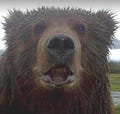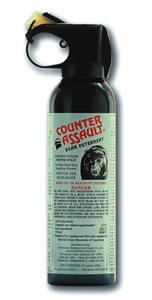By Jordan Schaul | National Geographic | July 12, 2011
Contributing Editor, Dr. Jordan Schaul, a member of the IUCN Bear Specialist Group and an ex-officio council member of the International Association for Bear Research and Management, briefly discusses his experience with bear spray.
In the wake of a fatal grizzly bear encounter near Yellowstone National Park, officials have issued a couple of reminders to recreational campers. One suggestion–carry bear spray. And remember to carry it in a holster!
These commercially available lacrymatory agents are derived from chili peppers. The active ingredient–oleoresin capiscum is used as both a defense spray and as a topical pain reliever. The EPA registered bear deterrents are nothing more than pepper spray, but try telling that to the bear or me for that matter.
Lachrymators stimulate corneal nerves which induce tearing and even temporary blindness. And they are quite suitable irritants of any tissues lined with mucus membranes.
At the Alaska Wildlife Conservation Center, we carry Counter Assault— CA-18H-Bear Deterrent (10.2 oz with Belt Holster) when we enter enclosures with bears or work with them through protected contact. At nearly $60 a canister it is expensive stuff, but with a range of 25 feet, the manufacturers suggest it is effective for “sudden close encounter defensive charges (from 15-25 feet), full defensive charges (from more than 50 feet away), and gradual continuous approaches.”
I find that few people that purchase bear spray have much insight into distinguishing among types of aggressive behaviors in bears. What’s important is that they selected a non-lethal deterent. Whether it is a provoked charge or an attack with predatory intent, the bear spray will likely ward off a bear.
Make sure you purchase a cannister with a holster. I have been sprayed, albeit accidentally, twice in my career because I was not carrying the spray can in the holster.
A young bear I was training, inadvertently punctured a cannister and it discharged. The grizzly headed straight to his pool and I went to clean off. The noxious irritant works. If nothing else it surprises both intended and unintended targets.
ABOUT NATIONAL GEOGRAPHIC SOCIETY
The National Geographic Society is a global nonprofit organization that uses the power of science, exploration, education and storytelling to illuminate and protect the wonder of our world. Since 1888, National Geographic has pushed the boundaries of exploration, investing in bold people and transformative ideas, providing more than 14,000 grants for work across all seven continents, reaching 3 million students each year through education offerings, and engaging audiences around the globe through signature experiences, stories and content. To learn more, visit www.nationalgeographic.org or follow us on Instagram, Twitter and Facebook.
MEET THE AUTHOR
Jordan Carlton Schaul With training in wildlife ecology, conservation medicine and comparative psychology, Dr. Schaul's contributions to Nat Geo Voices have covered a range of environmental and social topics. He draws particular attention to the plight of imperiled species highlighting issues at the juncture or nexus of sorta situ wildlife conservation and applied animal welfare. Sorta situ conservation practices are comprised of scientific management and stewardship of animal populations ex situ (in captivity / 'in human care') and in situ (free-ranging / 'in nature'). He also has a background in behavior management and training of companion animals and captive wildlife, as well as conservation marketing and digital publicity. Jordan has shared interviews with colleagues and public figures, as well as editorial news content. In addition, he has posted narratives describing his own work, which include the following examples: • Restoration of wood bison to the Interior of Alaska while (While Animal Curator at Alaska Wildlife Conservation Center and courtesy professor at the University of Alaska) • Rehabilitation of orphaned sloth bears exploited for tourists in South Asia (While executive consultant 'in-residence' at the Agra Bear Rescue Center managed by Wildlife SOS) • Censusing small wild cat (e.g. ocelot and margay) populations in the montane cloud forests of Costa Rica for popular publications with 'The Cat Whisperer' Mieshelle Nagelschneider • Evaluating the impact of ecotourism on marine mammal population stability and welfare off the coast of Mexico's Sea of Cortez (With Boston University's marine science program) Jordan was a director on boards of non-profit wildlife conservation organizations serving nations in Africa, North and South America and Southeast Asia. He is also a consultant to a human-wildlife conflict mitigation organization in the Pacific Northwest. Following animal curatorships in Alaska and California, he served as a charter board member of a zoo advocacy and outreach organization and later as its executive director. Jordan was a member of the Communication and Education Commission of the International Union for the Conservation of Nature (CEC-IUCN) and the Bear Specialist Group of the IUCN Species Survival Commission (BSG-SSC-IUCN). He has served on the advisory council of the National Wildlife Humane Society and in service to the Bear Taxon Advisory Group of the Association of Zoos and Aquariums (AZA Bear TAG). In addition he was an ex officio member of council of the International Association for Bear Research and Management.
Dr. Jordan Schaul is the founder of Schaul PR Group. He was a regular contributor to pop culture and science publications, including Nat Geo Voices & HuffPost.





